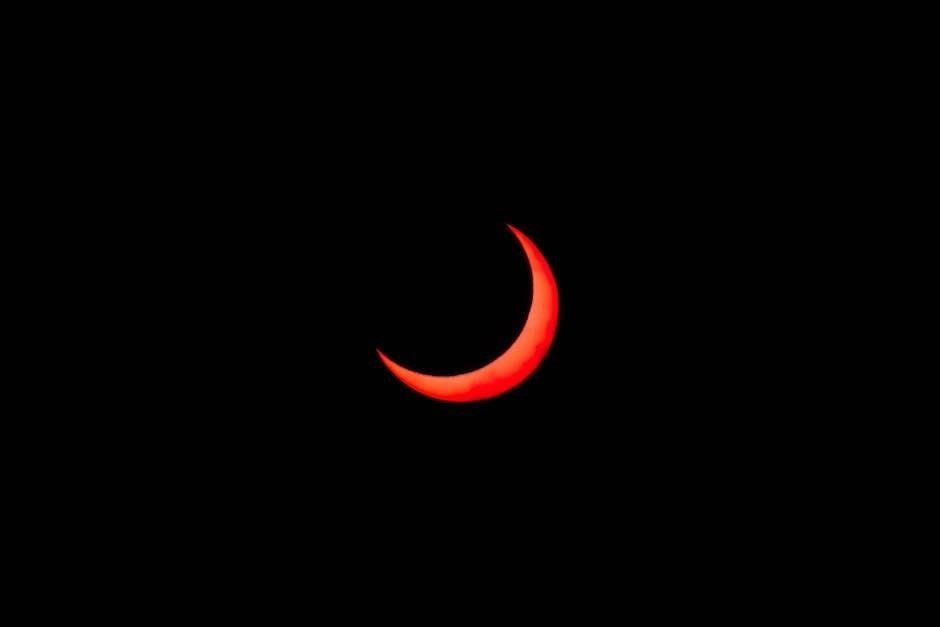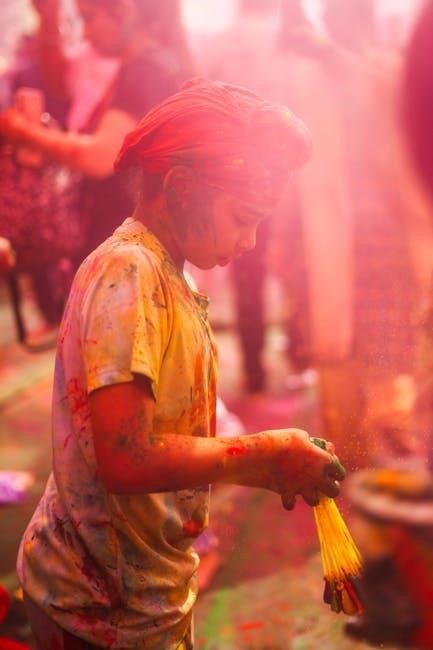The Red Moon captivates with its striking appearance and rich cultural significance, blending scientific wonder with spiritual symbolism, making it a timeless subject of fascination worldwide always․

What is a Red Moon?
A Red Moon refers to the dramatic reddish hue the Moon takes during a total lunar eclipse․ This phenomenon occurs when Earth positions itself between the Sun and the Moon, casting a shadow that scatters blue light while allowing red wavelengths to dominate․ The intensity of the color varies depending on atmospheric conditions․ Beyond its scientific explanation, the Red Moon has captivated cultures globally, often symbolizing transformation, renewal, or profound change․ It holds significant spiritual and cultural meaning, frequently featured in folklore, mythology, and modern interpretations as a harbinger of emotional or societal shifts․ The Red Moon’s rarity and striking appearance make it a mesmerizing event that unites astronomy and mysticism, inspiring both scientific curiosity and introspective reflection․
Historical and Cultural Significance
The Red Moon has captivated human imagination across centuries, embedding itself deeply in history, mythology, and culture․ Ancient civilizations often viewed it as an omen, symbolizing significant events or transformations․ In many cultures, it was associated with prophecy, divine messages, or impending change․ Some societies linked it to blood moons, tying it to apocalyptic beliefs, while others saw it as a harbinger of renewal․ Indigenous cultures worldwide developed rituals and stories to explain its occurrence, often connecting it to spiritual or cosmic events․ The Red Moon’s striking appearance has inspired countless myths, folklore, and artistic interpretations, making it a universal symbol of wonder and intrigue․ Its cultural significance endures, reflecting humanity’s enduring fascination with celestial phenomena and their deeper meanings․
Scientific Explanation of the Red Moon
The Red Moon, or Blood Moon, occurs during a total lunar eclipse when Earth blocks sunlight, scattering blue light and casting a reddish hue on the Moon․
Causes of the Red Moon Phenomenon
The Red Moon occurs during a total lunar eclipse when Earth positions itself between the Sun and the Moon, blocking direct sunlight․ This alignment causes the Sun’s rays to scatter through Earth’s atmosphere, filtering out blue and green light due to a phenomenon known as Rayleigh scattering․ The remaining red and orange wavelengths, which have longer frequencies, pass through and illuminate the Moon, giving it a striking reddish appearance․ The intensity of the color varies depending on atmospheric conditions, such as pollution levels and volcanic activity․ This natural wonder is both awe-inspiring and a testament to celestial mechanics, captivatingscientists and skygazers alike for centuries․
Frequency and Predictability of Red Moons
Red Moons occur during total lunar eclipses, which happen approximately 2-3 times a year, though not all are visible globally․ Their frequency depends on the alignment of Earth, Sun, and Moon, as lunar eclipses only occur during a full moon when the Moon passes through Earth’s umbra․ Astronomers can predict Red Moons with high accuracy using lunar eclipse cycles, such as the Saros cycle, which repeats every 18 years․ Weather conditions and the Moon’s orbital position influence visibility and intensity of the red hue․ While rare compared to partial eclipses, total lunar eclipses are predictable, allowing skygazers to plan observations well in advance․ This predictability makes Red Moons a popular and anticipated celestial event worldwide․
Cultural and Mythological Perspectives
The Red Moon has inspired countless myths, folklore, and spiritual practices worldwide, symbolizing transformation, prophecy, and divine connection across cultures, making it a profound cultural and mythological symbol․
Folklore and Myths Surrounding the Red Moon
Across cultures, the Red Moon has been a source of fascination and fear, often viewed as an omen of significant change or chaos․ In many Indigenous traditions, it symbolizes a time of transformation and renewal, while in European folklore, it is sometimes linked to werewolf legends and supernatural events․ Some cultures believe the Red Moon signals impending disaster or war, while others see it as a harbinger of spiritual awakening․ Its vivid color has inspired tales of blood moons, apocalyptic visions, and divine messages․ These stories reflect humanity’s deep connection to lunar cycles and the mysteries they evoke, making the Red Moon a timeless subject of myth and legend․
Modern Interpretations and Symbolism
In contemporary times, the Red Moon is often seen as a symbol of intense emotions, passion, and transformation․ It is frequently associated with themes of love, energy, and inner strength․ Many modern spiritual practices view the Red Moon as a powerful force for personal growth and self-reflection․ Artists and writers draw inspiration from its striking appearance, using it as a metaphor for change and renewal․ Additionally, the Red Moon has become a popular motif in photography and design, representing the beauty and mystery of celestial events․ Its symbolism continues to evolve, blending traditional myths with modern interpretations, making it a versatile and enduring icon in today’s culture․

Photographing the Red Moon
Capturing the Red Moon requires careful planning, the right equipment, and inspiration from its striking appearance, making it a unique and rewarding subject for photographers worldwide always․

Best Practices for Capturing the Red Moon
To capture the Red Moon effectively, plan meticulously and choose a location with minimal light pollution․ Arrive early to test your setup and compose shots․ Use a tripod for stability and a remote shutter release to avoid camera shake․ Shoot in RAW format to preserve detail and manually adjust settings for optimal exposure․ Experiment with foreground elements like landscapes or silhouettes to add depth․ Avoid over-editing to maintain the natural beauty of the scene․ Consider using apps like PhotoPills to plan your shots based on moonrise times and positions․ Patience is key, as the Red Moon’s appearance can vary, and timing is crucial for the best results․ Stay safe and prepared for varying weather conditions to ensure a successful shoot․

Equipment and Settings for Optimal Results
- Camera: Use a DSLR or mirrorless camera for high-quality images․
- Lens: A telephoto lens (at least 200mm) is ideal for capturing the moon’s details․
- Tripod: Essential for stability, especially at high zoom levels․
- Remote Shutter Release/Timer: Reduces camera shake during capture․
- Manual Mode: Adjust settings for precise control․
- ISO: Keep low (100-400) to minimize noise․
- Shutter Speed: Use 1/100 to 1/250 of a second for a sharp image․
- Aperture: Set between f/5․6 and f/8 for optimal depth and light․
- White Balance: Use ‘Daylight’ for accurate color representation․
For a larger perspective, use a wide-angle lens․ Always carry extra batteries and memory cards․ These settings ensure crisp, vibrant Red Moon photos․
Post-Processing Tips for Stunning Images

Enhance your Red Moon photos with careful editing․ Adjust the color balance to emphasize the red hues, and tweak exposure to reveal details in shadows and highlights․ Use noise reduction tools to eliminate grain without losing sharpness․ Sharpen the image subtly to maintain clarity․ Crop strategically to frame the moon effectively․ Experiment with layer blending in Photoshop or Lightroom for a natural look․ Avoid over-saturation to keep the image realistic․ Apply a subtle vignette to draw focus to the moon․ Save in high-resolution formats for printing or sharing․ These steps will transform your captures into breathtaking, professional-quality Red Moon images, preserving their natural beauty while enhancing visual appeal․

Spiritual and Ritual Practices

The Red Moon is a powerful symbol in spiritual rituals, often used for transformation, release, and renewal․ It amplifies energy work and manifestation practices, connecting deeply with intuition and cosmic cycles․
Full Moon Rituals and Their Significance
Full Moon rituals are deeply meaningful practices that align with the energetic peak of the lunar cycle․ They symbolize release, transformation, and celebration of accomplishments․ Many cultures and spiritual traditions use this time to let go of negative patterns, manifest desires, and honor life’s abundance․ Rituals often involve creating a sacred space, setting intentions, and using symbolic elements like candles, water, or crystals․ Journaling and meditation are common practices to reflect on progress and emotional states․ The Red Moon, with its intense energy, amplifies these rituals, making them particularly potent for personal growth and spiritual renewal․ Timing rituals during the exact full moon moment enhances their effectiveness, fostering a deeper connection to the universe and oneself․
Manifestation and Energy Work During the Red Moon
The Red Moon is a powerful time for manifestation and energy work, as its intense energy amplifies intentions and accelerates transformation․ This phase is ideal for releasing old patterns, embracing change, and aligning with personal goals․ Practitioners often use visualization, affirmations, and sacred rituals to harness the moon’s potent energy․ The Red Moon’s fiery vibe encourages boldness and clarity in setting intentions, making it a prime moment for spiritual growth and mindset shifts․ Many believe this time enhances the effectiveness of energy-clearing practices like smudging or sound healing․ By focusing on what you wish to create or release, you can deeply connect with the moon’s transformative power and manifest meaningful change in your life․ Proper preparation and mindfulness are key to maximizing its potential․

Viewing the Red Moon
The Red Moon offers a breathtaking spectacle, inspiring wonder and connection․ Plan with a Moon calendar, find optimal timing, and enjoy the celestial display in clear skies worldwide․
Best Locations for Observation
For optimal Red Moon viewing, choose locations with minimal light pollution and clear horizons․ Dark sky reserves, national parks, and remote rural areas offer ideal conditions․ Places like Joshua Tree, Yellowstone, or the Atacama Desert are renowned for their pristine skies․ Coastal areas with low humidity and high elevation, such as Mauna Kea in Hawaii or Mount Kilimanjaro, provide exceptional clarity․ Urban viewers can find elevated spots like rooftops or hills to minimize interference․ Timing is key—observe when the moon is at its highest point for the sharpest view․ Plan ahead using moon calendars to maximize your experience and ensure uninterrupted visibility of this celestial wonder․
Timing and Visibility Tips
Timing is crucial for witnessing the Red Moon․ It typically occurs during a total lunar eclipse when the Moon passes through Earth’s shadow․ For optimal visibility, observe when the Moon is high in the sky, usually around midnight․ Use a lunar calendar to pinpoint exact dates and times․ Check local weather forecasts to ensure clear skies․ Avoid areas with heavy cloud cover or light pollution for the best view․ binoculars can enhance detail, but the naked eye suffices․ Download sky-tracking apps like Sky Map or PhotoPills to locate the Moon’s position․ Plan ahead to find a spot with an unobstructed eastern horizon, as the Moon rises there․ Patience is key, as totality lasts about an hour, offering ample time to absorb this breathtaking phenomenon․
The Red Moon offers a blend of scientific marvel and cultural richness, inspiring awe and curiosity in all who witness it, making it a timeless wonder․
Final Thoughts on the Red Moon Experience
The Red Moon is a captivating phenomenon that blends science, culture, and spirituality, offering a unique experience for observers worldwide․ Its striking appearance invites reflection, wonder, and connection to ancient traditions․ Whether through photography, rituals, or simple contemplation, the Red Moon inspires personal growth and a deeper appreciation for nature’s beauty․ By understanding its causes and cultural significance, one can fully embrace its symbolic power․ As a rare and fleeting event, it reminds us to cherish moments of awe and harmony with the universe․ Prepare for the next Red Moon by setting intentions, capturing its beauty, and immersing yourself in its mystical energy․


